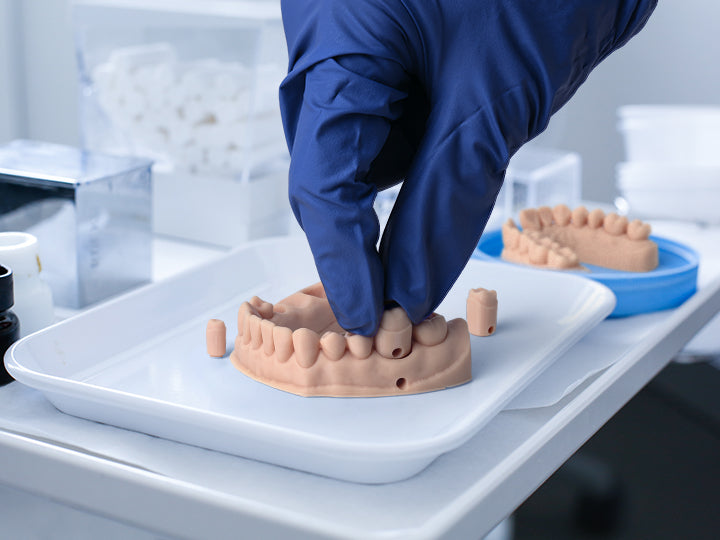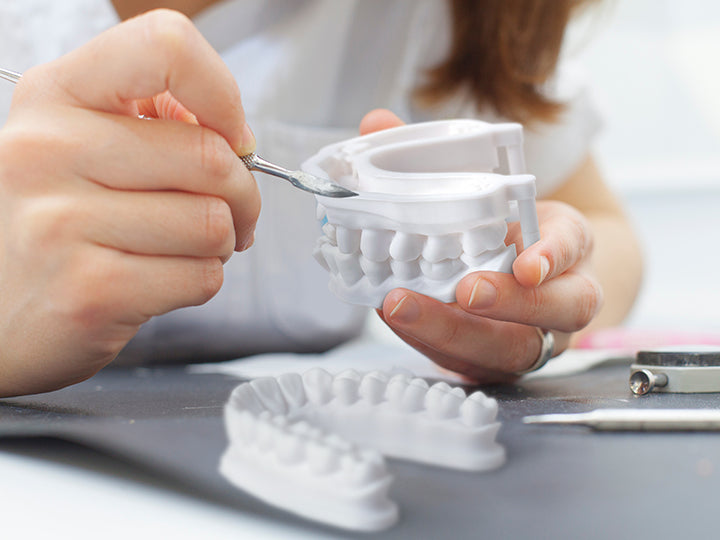The use of 3D printing technology in creating crown and bridge models has become increasingly popular due to its efficiency and accuracy. What used to be time-consuming, labor-intensive, and often prone to human errors can now be completed in an hour or less with a remarkable level of precision.
In this article, we'll take you through a step-by-step guide on how to incorporate 3D printing into your process of creating crown and bridge models with removable dies. It will cover everything from designing the model to the 3D printing process itself. Ensuring that your workflow will be quick and effective in producing accurate crown and bridge models.
Step 1: Scan
To begin the process of creating crown and bridge models, we first obtain a digital impression of our patient's intraoral condition. This digital impression serves as the foundation for designing and creating our CAD (Computer Aided Design) models.
There are two primary methods that can be used to obtain this data:
- Utilizing the intraoral dental scanner to scan the patient's teeth directly. The handheld scanner can be placed directly in the patient's mouth and captures images in real time, allowing for a comprehensive digital impression of the teeth and gums.
- Scan a physical model from convention impression using a desktop scanner. This method is often used in dental practices that do not have access to an intraoral scanner or for patients who are not suitable for intraoral scanning.
Regardless of which method is used, both are equally viable as long as the resulting digital impression can be saved in .STL file format.
Step 2: Design
Once we have obtained a digital impression of the patient's intraoral condition, the second step will be about designing and creating our CAD models.
Advanced CAD software such as Medit, Exocad, or 3Shape can be used to complete this step, and all are compatible with Phrozen dental series printers. In this guide, however, we will primarily use Medit Model Builder to design our crown and bridge models.
1. Create a Worksheet & Import Scans
Start by selecting the tooth position, design type, method, material, and shade. In this guide, we choose tooth number 24, crown (Type), temporary (Method), PMMA (Material), and no shade.
2. Trim Unnecessary Areas of the Scans
- The scan results usually will also capture the palate areas of the patient's mouth, which may not be necessary for the final design of our crown and bridge model. Therefore, you can trim these unnecessary areas to make the model more concise.

3. Creating a Base for Your Crown and Bridge Model
- Click the "Alignment Mode" button and place your scan data on the occlusal plane.

- Move around your scan in the "Multi-View" on the right to adjust its position on the occlusal plane.

- Go to "Base Creation Mode" to create your base and adjust its height if necessary.

4. Creating the Die
- Select the tooth number you want to create a die for, and manually draw a margin line around the tooth.


Step 3: Slicing
After completing the designing process, the next step is to prepare a 3D printing file, which is a process commonly known as slicing. In general, the process involves several steps that mainly focus on setting up your printing orientation, printing support, and resin profile.
To begin, open the Phrozen DS Slicer software and import your crown and bridge CAD model (in .STL file format).
(Note: If you're using the Medit Model Builder, you can directly transfer your CAD model file to Phrozen DS Slicer through Medit Link)
Print Orientation & Support
Crown and bridge models with removable dies typically consist of two parts - the body of the model and its removable dies. Each part requires its own printing orientation.
- For printing the body of the model, we highly recommend printing it solid and horizontally flat on the building plate, similar to the orientation used for printing aligner models and study models. This orientation will consume less resin and allow you to finish the printing process in 1 hour.

- For printing its removable dies, you can print them vertically flat on the building plate or print them vertically with support. It is important to note that if you plan to print the removable dies with support, make sure that your support structure doesn't touch the teeth and die socket area. Therefore ideally, you want the support to be added to the pin area of your removable dies.

Resin Profile
We recommend using our Phrozen Water-Washable Dental Model Resin for printing your removable die or crown and bridge models.
The material provides a remarkable post-curing accuracy, with print results exhibiting more than 90% of variation within ±0.05mm tolerance when compared to its original CAD files. This level of precision makes it an ideal choice for creating highly accurate crown and bridge models.
Additionally, the material is formulated to be easily rinsed with water providing safe and comfortable handling of the printed model.
To set your resin and its parameter:
- First, go to the settings menu by clicking the gear icon (⚙) located in the top right corner. Go to "Machine" from the sidebar menu and choose which printer you will use for printing.

- After choosing your printer, go to "Print" on the sidebar menu and then select "Phrozen Dental" and "Washable Dental Model" resin.

- Select the layer height that you want your model to be printed on. The lower the layer height, the higher the detail your printed object will have. However, lower layer heights require more layers to be printed, resulting in a longer printing time. We recommend printing your crown and bridge models either on 50 µm or 100 µm layer heights.

- Last but not least, select the parameter that best suits your printing requirements. Inside the DS Slicer software, the resin parameter has been meticulously tested by our dental technicians, so you no longer need to undergo trials and errors in dialing the resin parameter. You can select the "Stable" setting for moderate printing speed or the "Turbo" setting for faster printing speeds.

After setting up your printing orientation, printing support, and resin parameter, double-check everything again, then click the "Single Para Slice" button to slice the model.
Step 4: File Transfer
Once it finishes slicing (don't forget to name the file), the sliced file will automatically be converted into a .ZIP file format. You can save this sliced file either to a USB drive or send it directly to your printer through network sending.
To save your files via USB:
- Click the "Open the Folder" button and select the file you want to save to the USB. Make sure that the file is saved in .ZIP format.
To save & send your files via Network Sending:
Click the "Network sending" button, then enter the IP address of your printer. Make sure that the IP address you enter matches the IP address of your printer.
Step 5: Printing
Start by shaking the resin well and pouring it into the vat up to half or three-quarters of its maximum capacity. Don’t forget to double-check that all the screws (two thumbs screws on the building plate & two side screws on the vat) are tightened properly.

To start printing your crown and bridge models via USB:
- Plug in your USB drive to the printer.
- On the printer’s touch panel, click the "Print" button.
- Then click on the USB icon at the bottom.
- Select the file print you intend to print.
- After that, a pop-up will appear. Click “Yes” to initiate the printing process
To start printing your crown and bridge models via Network Sending (WiFi):
- Enter the Phrozen OS interface by clicking "Open page" or by typing in the IP address of your printer.
- Go to the "PLATES" section.
- Choose the file (based on the file name) you intend to print, and click the “Print” button on your screen. The printer would then automatically start the printing process.
(Click the following link here to see more details on how to start the printing process using the Phrozen Dental 2022 series)
Step 6: Post-Processing
Removing your crown and bridge model from the building plate:
Use a metal scraper to complete this step. Insert the scrapper into the edge of your crown and bridge model, then apply constant but light pressure to remove them from the building plate.
(Note: Avoid using excessive force as it can damage the printed objects and hurt our hands in the process)

Cleaning your crown and bridge model:
For the cleaning process, place the crown and bridge model inside an ultrasonic cleaner filled with clean water for 5 minutes. Be sure to handle the model gently and avoid rubbing or brushing during the cleaning process, as this could cause over-cleaning and affect its dimensional accuracy.

Drying your crown and bridge model:
For the drying process, let the model sit in a dark place for up to 30 minutes. Or alternatively, you can use a compressed air gun to immediately dry your models.
Post-curing your crown and bridge model:
For the curing process, place the crown and bridge model inside the Phrozen Cure or other Phrozen post-curing stations like Cure Luna or Cure Mega for 30 minutes. Optionally, you can also utilize other post-curing devices as long as they emit the same 405 nm wavelength. This will ensure that the resin is cured and hardened properly.

How much you save with Phrozen Dental?
Phrozen Dental 3D Print Solution for Crown and Bridge Models:




